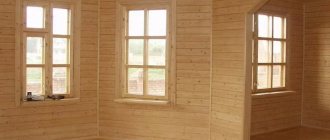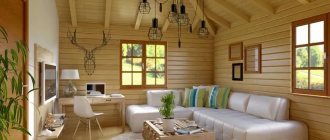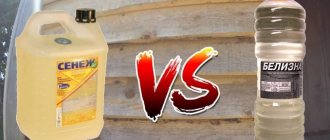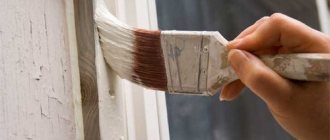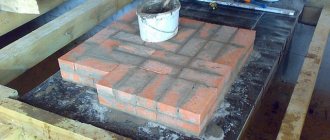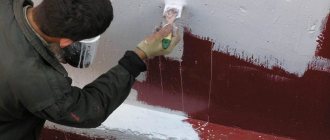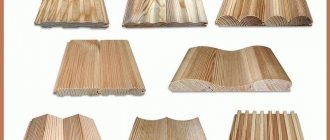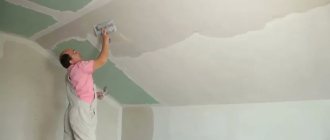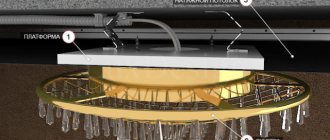Lining is a thin finishing board with a special tongue-and-groove joint. After covering the surface of the walls, ceiling or floor, it must be covered with protective compounds. It can be acrylic, stain, adhesive primer, drying oil, antiseptic, fire retardant or oil-wax. It all depends on the purpose and purpose of the protective layer. From this material you will learn in more detail how to treat lining inside a house, and why a protective layer is needed at all. And also, which manufacturers’ formulations protect wood better than products from other brands.
Processed lining with stain, as well as by brushing (aging) Source 2gis.ru
Types of funds
Coverings for lining are divided into two main groups: protective and finishing (decorative). The first group includes compounds that have different working functions. Some are impregnations, others are covering materials. Both of them create a barrier against negative external factors.
Impregnations suitable for lining:
- covering soil;
- stain;
- wax;
- oil;
- specialized impregnation;
- antiseptics;
- drying oil;
- bleach;
- fire retardant
Several layers of stain with and without the addition of toners look different Source elka-palka.ru
Covering finishing materials act as a decorative layer, simultaneously serving as both protection and decoration. When there is no desire to cover up the wood pattern and its color, the coating composition is chosen from among the following translucent options:
- glossy or matte clear varnishes;
- tinted clear varnishes;
- translucent varnishes;
- wax;
- aqualak on acrylic;
- translucent enamel;
- decorative azure.
Brushed lining is coated with water-soluble transparent varnish Source 1povagonke.ru
For other cases, in which the natural color, texture and pattern of the board are unimportant, the lining inside the house is processed using covering materials. These include:
- acrylate, acrylic paints;
- oil paints;
- water-based paints.
Painting new lining with acrylic paint - the first layer of light green color Source sparta-stroy.ru
Wax belongs to the group of coating materials and impregnations. It all depends on the technology and the thickness of the applied layer. The degree of gloss of the coating depends on the duration and technique of polishing during waxing. In this case, wax can be called a coating material. The longer the procedure is carried out, the more the working wax surface approaches gloss. The less and less intensive grinding is done, the more the matte structure of the wax coating is preserved.
What is the best way to process it?
There are a large number of wood processing products available on the market. Information about the most popular drugs will help potential buyers make it easier to choose a purchase.
Fire retardants
The lining located inside the house next to heating devices must be protected from possible ignition. For this purpose, flame retardant impregnations are used, which are not easy to apply yourself.
It is much more convenient to buy clapboard for the dacha, pre-impregnated with fire-fighting substances. In rooms with a moisture concentration not exceeding 70%, the lining can be coated with solutions of moderate resistance. Inside the house, the applied composition will remain for a long time, it costs much less than a weather-resistant solution.
Antiseptics
A strong risk factor for wood damage is microbiological exposure. They get rid of it with the help of antiseptics. Antimicrobial solutions that can be used to impregnate wood cope with biological contaminants and prevent the emergence of new areas of mold and rot. Antiseptics have a pungent odor that does not disappear for a long time, and you need to pay attention to this when purchasing, having studied reviews of the product.
Preparations that cost more than conventional disinfectants can not only protect against microorganisms, but also at the same time improve the aesthetic impression and increase the ability to repel water molecules.
Stains
Special liquids based on water, alcohol or organic solvents that penetrate deep into the wood and create a specific color or shade are called stains. The term has a foreign synonym – beitz. The solutions do not protect, but only tint the wood, although there are special types of expensive stains with a pronounced protective effect.
Note! In any case, after applying stain to the lining inside the dacha, it must be varnished on top. Otherwise, the tree will not retain its original appearance.
Sometimes wood planks have dark spots, the appearance of which remains a mystery. You can treat such areas with bleach, carefully selecting the concentration and exposure time. You can practice on lining waste, see how many tones the wood base is lightened by, and draw the appropriate conclusions.
Varnishes have a good protective effect on the lining inside a cottage or residential building. They can also be used to cover the lining to achieve a decorative effect. Acrylic-based varnish compositions decorate the surface well and create a biological barrier on it.
Due to the minimal allergenicity indoors, it makes sense to use aqualak. It takes longer to dry than solutions in organic liquids, but is safer for health. With aqualas you can create a completely or slightly matte, as well as a glossy surface.
If you add color to the solutions, you get a colored product with the desired shade. This composition will not last long on the outside, so it is not recommended for outdoor use. Water-based varnishes create a barrier to steam penetration, eliminating contamination of open pores.
Note! Some modifications of aqualak contain antimicrobial additives, which significantly improves the safety of the lining inside the house.
Other compositions contain substances that neutralize the effects of UV rays. It makes sense to use such compositions on walls that are illuminated by the sun for most of the day.
Why use impregnation?
Some owners have doubts about the need to impregnate wood paneling inside a suburban building. If the boards are not covered, changes will be noticeable on them after some time. With poor ventilation, the lining will appear blue; as a result of intense sunlight, it may become dark gray.
The blueness is explained by the action of microorganisms, which can be gotten rid of with the help of active oxidizing agents, such as chlorine. The procedure is not very easy to perform and is accompanied by the release of an unpleasant odor.
The plaque, which has turned gray from the sun, can be removed by mechanical grinding of the lining, but the positive effect will not last long. It is more advisable to carry out the treatment immediately after finishing, so as not to have problems later.
In addition, the coating transforms the wood and makes the interior special. Lining coated with waterproof impregnation can last longer even in an irregularly heated, damp room.
Option #1
Connection of plastic and MDF panels:
- H-shaped PVC profile. Most often, joining along the length of plastic and MDF linings is done using H-shaped PVC profiles, as in the photo below. In this version, the planks are simply inserted into the profile on both sides. The downside is that such a profile is visible, and in the case of MDF it also differs in texture.
The H-shaped profile is considered universal, but it is visible
- Thin straight and corner strips. Manufacturers of MDF panels produce thin strips that are glued to the connection line; these strips can be straight or angular.
- T-shaped moldings . They are inserted into the gap between the panels.
T-shaped moldings for hiding the joints between MDF panels are very easy to use
How to effectively protect a tree
How to treat the lining inside the house? This question is often asked by owners who have used wood in the interior decoration of their home.
Today, processing lining inside the house is not a problem. You just need to choose the right protective coating that will suit a particular room.
Some are more suitable for rooms with high humidity, others perfectly protect boards from ultraviolet rays, and some generally increase the strength of wood and prevent the risk of premature abrasion.
But also an important factor when processing is that the protection should look good on the boards . It should not distort the natural structure of the tree. On the contrary, its task is to emphasize the naturalness of the material used and blend harmoniously with the rest of the interior.
Most often, the following substances are used to protect wood:
Lining protection. Features and feasibility
You should not apply a huge amount of protective agents to the finishing of the room. It is worth limiting yourself to 1-3 options that will be truly appropriate for a particular room. The covering of wooden lining inside a residential building and inside a dacha, where the owners appear a couple of times a year, should be different.
For high-quality setting of protective equipment, before carrying out work, both new and used lining should be cleaned of debris, dust, and covered with a layer of primer. The liquid primer is quickly absorbed into medium-density wood and creates a good base for applying chemicals.
Antiseptics
Must be applied to any type of wooden lining. This is the main layer of protection for medium-density wood (linden, alder, etc.). Antiseptics prevent wood from rotting in places where moisture accumulates. A water-based liquid antiseptic is applied with a brush or roller to the lining sheets that have not yet been installed, after which they are absorbed by the wood for 1-2 days.
Particular attention should be paid to the locks on the lining and the cut points. In the first case, the antiseptic must be “poured” into the cracks so that there are no uncovered areas left. In the second, simply go through the liquid solution again 1-3 hours before installing the sheets.
Often, anti-rotting agents are applied to the lining during production. Long-term storage in poorly ventilated warehouses or transportation in unfavorable conditions affects the quality of the lining, contributes to the occurrence of rot, fungus, etc. It is worth carefully studying the data sheet of materials to determine the feasibility of purchasing and applying various products.
UV protection
More expensive and specific type of protection. Suitable for rooms with windows on the sunny side of the house. It is a medium-thick liquid, applied last (after antiseptics and other products, including clear varnish).
UV protection prevents lining from “fading”—loss or change in color due to prolonged exposure to sunlight. A topical product for covering the finishing of a cottage or country house with large windows, provided that the lining is not painted with oil paint. Clear varnishes and stains can be combined with this type of coating, but if you have the funds, you should think about buying a combined product (varnish + UV protection in one mixture).
Protection from physical damage
Mixtures to increase the density of the material. The main reason to purchase them is to improve the quality of softwood lining. Small scratches, cracks, and dents darken over time and can significantly spoil the appearance of the finish. This type of protection is relevant for rooms with eurolining, which are often visited by people (hall, corridor).
Ignition protection
How to cover lining in a residential building to prevent fires? A special composition that prevents the tree from catching fire at the slightest spark. It is used everywhere, especially in rooms with a complex wiring system, an installed fireplace, or in rooms where people often smoke. Often this layer of protection is also applied at the factory. The product is not too expensive, but for a large room the price may be an issue.
Tips for choosing a finishing coating for wooden lining
- color . Since stain or paint changes the color or shade of the lining, you need to use this property. For example, light shades visually increase the space. The use of different colors/shades allows you to zone the room;
- compound . The prefix “bio” after the name of the varnish indicates the absence of harmful substances. This composition can be used for interior work;
- manufacturer . Many domestic analogues of lining varnish or paint can create worthy competition for foreign goods. At the same time, the price of the product will be more humane.
How and with what to paint the lining in the bathhouse and steam room
Wax composition Evrotex-Sauna for lining in a bathhouse Due to the high temperature, it is better not to paint the lining in a bathhouse, but to treat it with protective compounds.
An excellent solution would be to use wax compounds, for example, Evrotex-Sauna. This coating is suitable for use in conditions of high temperature and cyclic intensive humidification.
Advice. You only need to apply the varnish once in the sauna. In the dressing room - you can make several layers.
How and with what to paint the lining on the veranda
The veranda or terrace is exposed to the greatest influence of atmospheric factors, so the material must be resistant. First coat with a layer of primer, and then 2-3 layers of varnish or paint.
How and with what to paint the lining inside/outside the house
There are no particular differences in painting a house outside or inside. The only difference is in the coatings used. Varnish/paint for interior work must meet environmentally friendly requirements. For outdoor work, it is more important that the coating can withstand moisture, temperature changes, and exposure to UV rays. The same type of paint can be used inside and outside a building. The difference is in the number of layers applied.
How to paint lining correctly - tool
To paint the lining you can use:
- brush. They are convenient because they allow you to paint wood in corners and hard-to-reach places. The paint is applied most evenly with a brush;
Advice. To apply the paint with a brush evenly and avoid smudges, you need to immerse the brush halfway in the paint.
- roller Allows you to paint quickly. However, to obtain a uniform layer you need to paint several times;
- spray. Allows you to get the job done as quickly as possible. But it increases paint consumption;
- mitten (chain-shaped). It is convenient to use a glove to paint (impregnate) the places where the lining joins (frames) the pipes;
- foam sponge.
Manufacturers of wood treatment products
Not all products on the market are of the highest quality. But there are a number of manufacturers who have been receiving positive recommendations from consumers for several years. Among the many offers on the market, the following brands of varnishes and wood paints stand out:
- Finncolor (Russia). Acrylate gloss and semi-gloss varnishes are easy to dilute with water while working. Pigments can be added to them. They are great for covering ceilings, walls, niches, door openings, and windows. Not for use on floors or furniture. The main function of protection is to stop the natural destruction of wood, to create a barrier when dirt, moisture, and harmful microorganisms (mold, mildew) get on the surface. Average costs - 1 liter per area of 5-12 square meters. m. Blend – 9 l. Approximate price – 2000 rubles.
- Composite (Russia). A quick-drying varnish without color or pungent odor is suitable for walls, ceilings, wood materials such as lining, non-laminated chipboard, fibreboard, OSB and MDF. One liter of product will cover an area of 8-12 square meters. m. Price for 1-3 liters – from 300 rubles, 10 liters – 2200 rubles.
- Commander (Finland). Varnishes with a ready-made coating of varying degrees of gloss. They are environmentally friendly, do not have a sharp specific odor, and can be used in children's rooms. The layer of varnish on the lining easily repels dirt and water and does not absorb fats. Consumption – 1 liter per 8-12 square meters. m. Small containers of 0.9 liters priced from 350 rubles. Medium (2.7 l) and large (9 l), respectively, cost more.
- Eurotex (Russia). The “Sauna” modifier is an ideal solution for rooms with high humidity. The product is used for bathrooms lined with lining, kitchens, baths, saunas. The composition contains wax, densely distributed over the surface, capable of withstanding high temperatures and humidity. The average price for 2.5 liters is 500 rubles.
- Colorex (Sweden). “Panellac” is an excellent primer for processing lining from new boards and an ideal finishing coat for already finished euro lining. Can be used on walls, ceilings and even furniture. Well protects wood from discoloration and aging, scratches due to mechanical stress. It has a hardening effect on wood. For 8-14 sq. m. only 1 liter is spent. Cost for 0.9 l - 750 rubles, 2.7 l - 1800 rubles, 9 l - 5000 rubles. “Supisauna” is an effective matte varnish for rooms with high humidity. Protects the lining from rot and darkening. Prices - 600-4000 rubles, depending on the volume of displacement.
- Belinka (Slovenia). Due to the fact that there are no biocides in the composition, the paint can be used inside the house. Thin-layer and colorless coatings are suitable for wood. They only give a matte shine. Very economical consumption - for 3 layers of 10-12 sq. m. area is enough for 1 liter. The approximate cost for 1-2.5 liters is from 600 rubles.
- Pinotex (Estonia). The “Interior” collection was released specifically for treating surfaces inside the house. The impregnation is a transparent, odorless liquid that is easily distributed over the surface of the lining. Composition: alkyd resin, light-resistant pigments, water. Blend volumes – 1.3-10 l. Costs on average are 1 liter per 8-16 square meters. m. Price – from 650 rub.
Translucent varnish “Commander” Source ales-spb.ru
Belinka brightening varnish is applied in one layer over untreated lining Source bsm21.ru
Varnishes and paints are applied with a brush and a roller made of a fur coat. On large areas, the lining is processed using special pneumatic devices - spray guns. They allow you to distribute the product evenly by spraying.
Consumption! The amount of material spent depends on the quality of the board, the number of layers, as well as the primary processing. The very first layer will be absorbed fastest and most deeply. If the structure of the wood is too “porous”, then the varnish or paint on the first layer goes deep into the microspace between the fibers.
Types of compositions
How to cover the lining inside a house is an easily resolved question, because there are many products on sale for different climatic zones and types of buildings.
Composite impregnations are designed to perform several functions, the main ones of which are the following:
- decreased flammability,
- protection against microbes,
- improvement of appearance,
- increasing mechanical strength.
There are products designed primarily to protect the lining, and compositions created for a decorative effect. Many drugs perform multiple functions equally successfully.
Main types of antiseptics
The main requirement for any antiseptic impregnation is protection, and regardless of the place of use, it must be waterproof.
Today it is not a problem to choose the right composition, because manufacturers produce narrowly targeted lines, for example, special ones for baths or saunas , based on wax, which will prevent the lining from darkening over time, forming a stable film on the surface of the material.
In addition, using an antiseptic you can give the surface a glossy shine or change the color. And if you are going to paint the lining, then experts recommend using a translucent antiseptic.
It will serve as additional protection and will muffle the bright wooden ornament, so the paint can be applied in one layer.
There is old clapboard on the walls. How to clean it? Restore original color?
To do this, you can use a flat pumice stone or an abrasive wheel. As a result of sanding, the shalevka loses all its protective properties, which means it must be coated with an appropriate antiseptic solution, which not only plays a protective role, but also preserves all the properties of the paint.
Once the preparation is complete, the paint can be coated.
If you use classic paint, it will preserve the original upholstery pattern and will not require additional finishing. If the coating is opaque and completely hides the wood grain, to achieve an attractive and original look, you should take care of additional decorations, for example, elements for decorating windows and floors.
Required tools and materials
In addition to the impregnating composition itself, you need to prepare tools for application. This could be a spray gun or a set of brushes of different sizes. The product packaging provides detailed application instructions and recommended tools.
Also useful for work:
- construction tape;
- absorbent wipes;
- container for coloring product;
- sandpaper No. 240.
To coat the joint areas, it is better to prepare a separate small brush. To prevent lint from sticking to the surface, instruments should be periodically rinsed in a soapy solution. It is worth doing this before you start applying the product.
Reasons why lining should be processed
The pleasant color of untreated lining will not please the eye for long. The wood will begin to deteriorate during use inside the house. Before you look for how to process the lining, you need to understand the reasons why it loses its beautiful appearance. Wood can be affected by dampness, attack by pests and, finally, even the simplest grease stains and abrasions.
Several main reasons why lining needs treatment with protective agents:
- Waterproofing. Boards become more resistant to water if there is high humidity in the room.
- Antiseptic. Fungal spores and mold microorganisms will not be able to get into the very depths of microcracks in the fibrous structure of the tree.
- Barrier against pests. No bark beetle (wood borer) or any other insect pest can destroy the wooden covering.
- Color preservation. The treated lining does not darken over time and retains its natural color throughout its entire service life.
- Health safety. If the lining is made of coniferous wood, then the release of their resins from the board stops after it is treated with protection. This nuance is important for rooms where people sleep or stay most often.
- Fire safety. The high flammability of wood can be reduced if it is treated with fire retardants in several layers.
Impregnation ensures the brightness and preservation of the color of the lining Source winterhouse.ru
Treating the wood surface with a fire retardant to protect it from fire Source sigma01.ru
The tree will retain its integrity longer in conditions of high humidity because the protective layer of impregnation or covering material will prevent it from swelling and rotting. When attacked by small insects, a layer of protection will prevent the wood from turning into dust. If a protective layer of impregnation is periodically applied to the surface of unpainted lining, then it will become stained and retain all its design properties - color, texture of smooth curves, pattern of wood stains.
Features of applying impregnation
There are several types of lining; they differ in the number and shape of joints on the resulting surface. Depending on this, a different amount of effort will be required to prepare it.
In any case, before covering the lining with any means, you need to carefully examine all the boards. If there are dark spots, local lightening is carried out with bleach. Then the entire surface can be lightly washed with a diluted soda solution and wait until the water has completely evaporated. Only after this can the wood be treated with primer and the base compound or immediately with impregnation.
The cracks are covered with wood putty, everything is thoroughly cleaned with sandpaper.
To more effectively secure the decorative layer, the wood is primed. Very carefully you need to distribute the primer mass in the seams. To apply primer over the main part of the area, you can use a spray gun; at the joints it is better to prime with a brush.
Each product has its own application characteristics, which are necessarily described in the manufacturer’s recommendations. The accompanying documents must be carefully studied and the compositions prepared in accordance with the instructions. All products are applied in several stages; each subsequent stage can be performed only after the surface has dried, and the final layer must be the thinnest. Following these rules will help you get a reliable and beautiful coating.
Preparatory work
Applying paint to the lining with a spray gun
Before impregnation, you need to assess the condition of the boards. If there are dark spots on them, they are removed with a special bleach. The surface is wiped with a soda solution (0.3 kg per 10 liters of water). This procedure is done before impregnating fresh lining, and also if the boards were previously varnished and the coating is still in good condition. When the surface is completely dry, it can be primed and painted according to the instructions.
If the paint coating has lost its presentable appearance, or has begun to crack and peel, the previous layer must be removed. This can be done in different ways. If the new coating is planned to be made transparent, a mechanical method is suitable. To do this, the surface is heated with a hair dryer. When the coating begins to separate, it is removed with a spatula. To remove oil paint, the following modification of the method is used: foil is laid on the boards and ironed on top with a heated iron. The separated composition is collected with a spatula.
If the lining will be painted, special removers can be used to remove the old coating. This is a fairly aggressive method, and the products can whiten the surface unevenly. If the owners plan to apply a colorless coating, it is better not to risk it and remove the old paint by heating. After using a chemical remover, the surface is washed well with water. If there are metal inserts on the surface, wipe them with vinegar.
